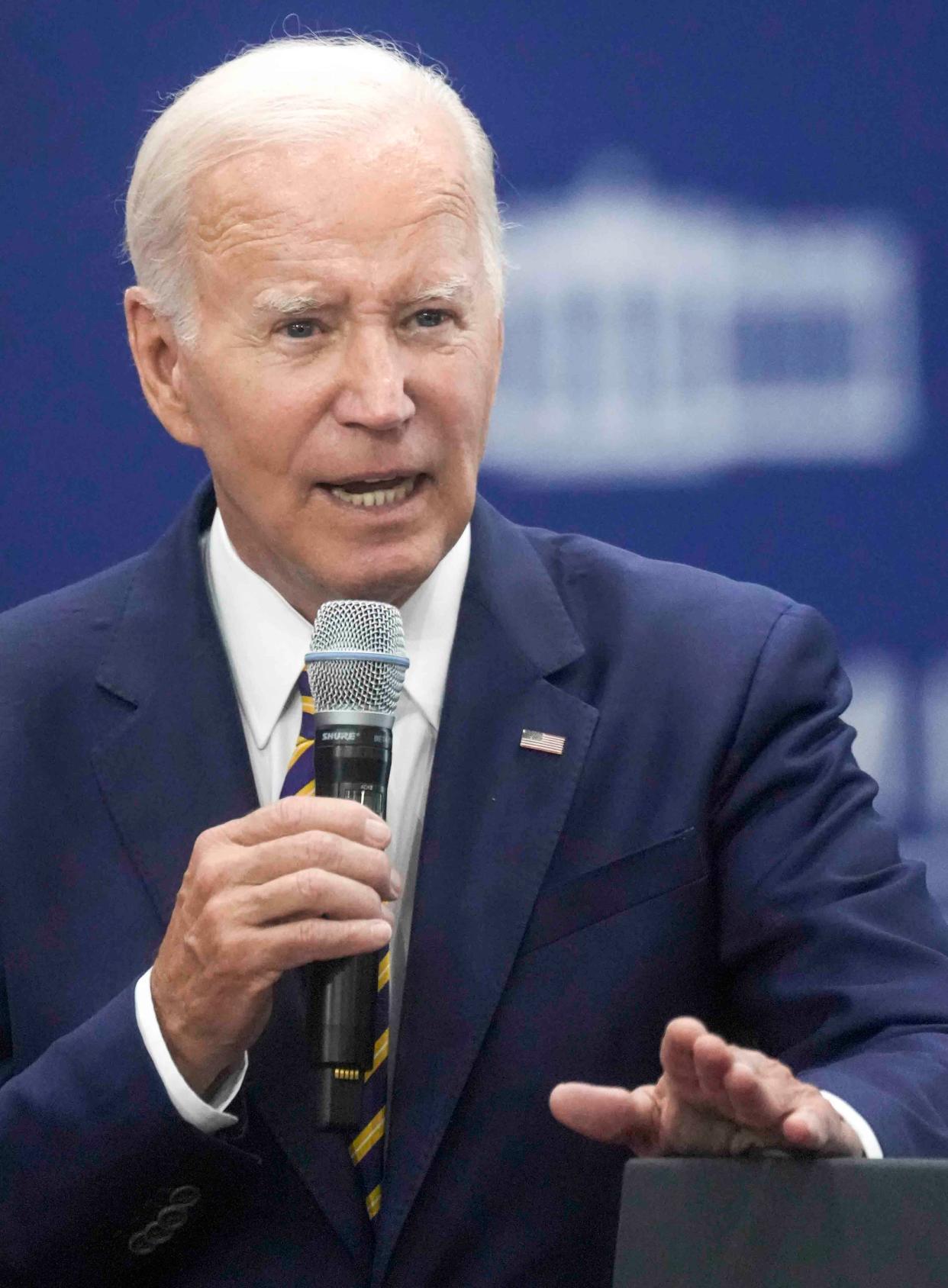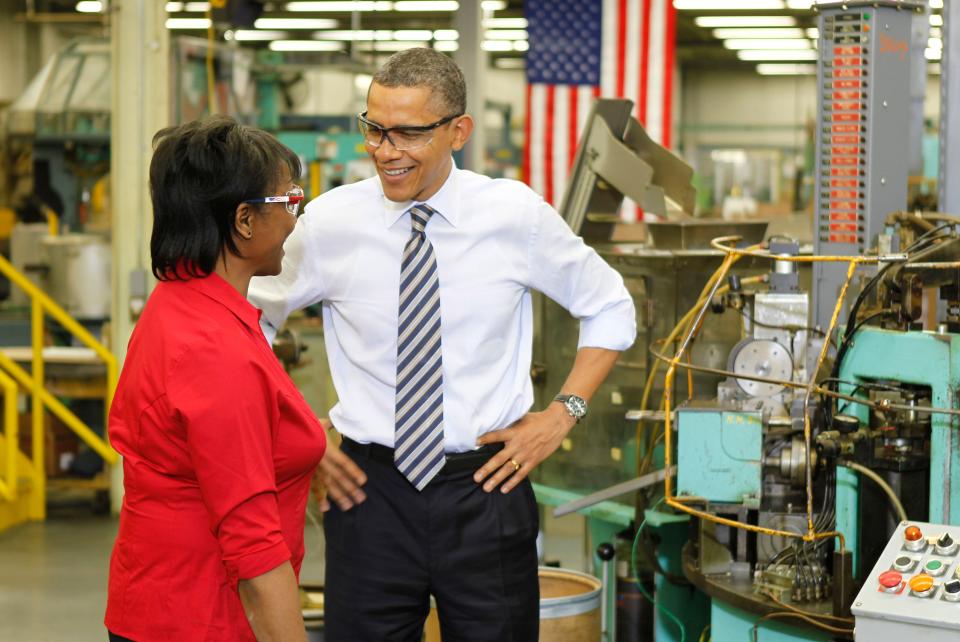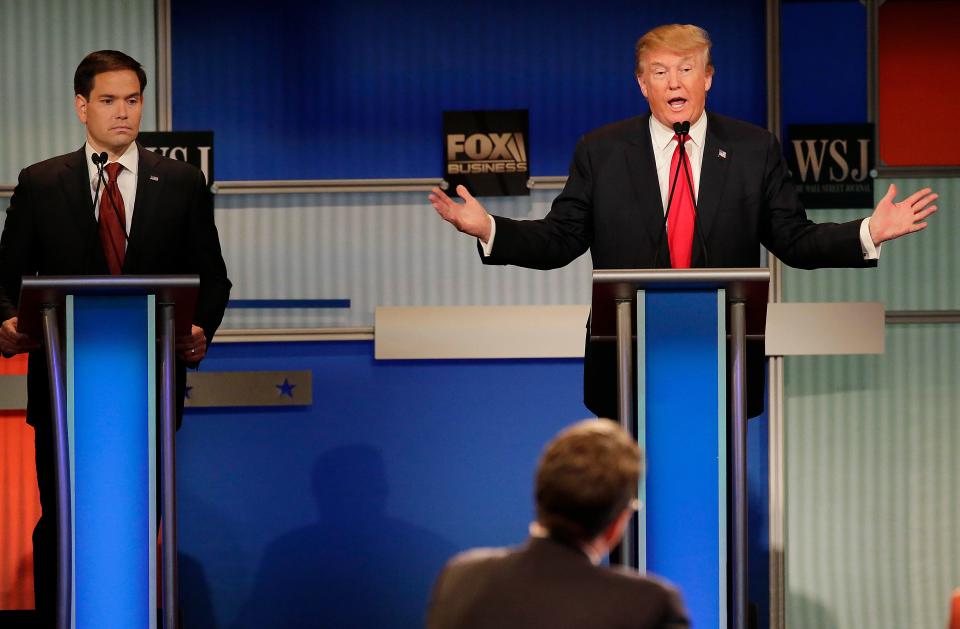What Joe Biden's negative poll numbers say about his re-election chances

- Oops!Something went wrong.Please try again later.
- Oops!Something went wrong.Please try again later.
- Oops!Something went wrong.Please try again later.
President Joe Biden has had persistently negative poll numbers ever since the fall of his first year in office in 2021.
There is no dressing that up.
But because his predecessor (Donald Trump) was also unpopular, and because that unpopular ex-president is Biden’s most likely opponent next year, it’s hard to know exactly how dire Biden’s situation is.

Would Biden’s unpopularity — if it persists — all but doom him to defeat? Or simply to another close election like the ones in 2020 and 2016?
What does it mean these days to be an unpopular president when unpopularity seems to come with the job and voters are chronically unhappy with where the country is headed?
More: President Joe Biden coming to Milwaukee to tout small-business growth, economic policies
I looked back over 12 years of polling (more than 70 surveys) in battleground Wisconsin to see what it tells us about the popularity ratings of presidents and governors and whether those numbers are reliable election barometers.
I looked at two kinds of measures: “net favorability,” which refers to the difference between the share of voters who view a politician favorably and the share who view that politician unfavorably; and “net approval,” which is the difference between the share of voters who approve of the job that an incumbent is doing and the share who disapprove. These two measures often (but not always) produce similar results.
Let’s start with presidents.
The Marquette Law School poll began in early 2012. It polled almost 40 times on President Barack Obama between 2012 and 2017. Obama almost never had a negative favorability rating here (three times in 37 polls). On average, the percentage of Wisconsin voters who viewed him positively over those five years (52%) was 8 points higher than the share who viewed him negatively (44%).

His job approval ratings were a bit lower than his favorability ratings and dipped into negative territory more often. More voters liked Obama personally than the job he was doing. But his average net job approval in Wisconsin from 2012 through 2016 was also positive (49% approve, 46% disapprove).
By contrast, the two presidents who have followed Obama — Trump and Biden — have had consistently negative ratings. In fact, they’ve almost never had a positive favorability or job rating in Wisconsin.
In 24 Marquette polls during his one term, Trump had an average net favorability of minus 8: 44% viewed him favorably and 52% unfavorably. That is 16 points worse than Obama’s net favorability as president from 2012 through 2016. Trump never registered a positive rating among registered voters in Wisconsin in those 24 polls. His average net approval rating was minus 6 (45% approve, 51% disapprove). Slightly more people disliked Trump personally than disapproved of his performance in office — the inverse of the Obama pattern.

How about Biden? Only once has he registered a positive favorability rating or job rating as president in Marquette’s Wisconsin polling — and that was the first Marquette poll of his first term, August of 2021. After that, his standing in Wisconsin and nationally turned downward and has never recovered.
Over his first term, Biden has had an average net favorability rating of minus 10 across 11 Marquette surveys from 2021 through 2023. His net job approval in Wisconsin over those three years is minus 11, which is even worse than Trump’s four-year average as president.
I think we can agree those numbers are bad for Biden.
But what exactly do they mean for his re-election prospects?
Many Democrats are understandably dismayed by Biden’s polling, though some believe these numbers overstate Biden’s plight for at least two reasons.
Donald Trump's popularity worsened post-presidency
One is that if Trump turns out to be the GOP nominee, Biden will be facing someone who right now is even more unpopular than Biden. In Marquette’s two polls this year, Trump has averaged a 35% positive rating and 63% negative rating. Those are Trump’s worst numbers since before he became president in 2017, and they’re much worse than Biden’s numbers.
The other argument is that unpopularity doesn’t tell us as much as it did in the past because voters are not only more deeply polarized today but have grown increasingly negative and pessimistic about where the country is headed.
Nationally, starting with George W. Bush’s second term (2005 through 2008), the last four presidents have suffered much more consistently negative approval ratings than their predecessors, raising the question of whether presidential disapproval is as much a measure of broad public dissatisfaction as it is of views of a particular president. (Of course, either way, it's not good for the incumbent).
Broad measures of the public mood have worsened nationally since the mid-2000s, like the share of people who say the country is on the wrong track or the share who say they’re satisfied with the way things are going. These polling questions used to be more widely viewed as a kind of referendum on an incumbent president or incumbent governor.
But as these mood indicators have turned downward, they have become more unreliable as election barometers. One reason is that lots of people in both parties are unhappy these days. An unhappy Republican is overwhelmingly likely to vote against an incumbent Democratic president. But unhappy Democrats may simply be mad at Republicans and are still quite likely to support their own party for president.
Another reason is that even if widespread public pessimism is bad for incumbents, elections are still choices, and sometimes the challenger is even more unpopular than the incumbent.
Over the past decade or more, we’ve seen several examples of a disconnect between the public mood and the re-election performance of presidents and governors.
For example, Obama was re-elected in 2012 despite negative public attitudes about the direction of the country.
In Wisconsin, Republican Gov. Scott Walker lost his bid for a third term to Democrat Tony Evers in 2018 despite positive public attitudes about the direction of the state.
Four years later, Evers won re-election despite negative public attitudes about the direction of the state.
Even job approval and favorability — more direct measures of an incumbent’s political standing — have been imperfect election barometers in Wisconsin.
In 2016, Trump defeated Hillary Clinton in Wisconsin for president despite having terrible popularity ratings —even worse than Clinton’s. But an unusually large slice of the electorate — about 20% — disliked both nominees and exit polls suggested they voted decisively for Trump.
In 2018, Walker lost his bid for a third term even though his job ratings were slightly positive — in part because voters had “Walker fatigue” after his two stormy terms in office.
In 2020, Trump almost carried Wisconsin despite consistently negative approval ratings and favorability ratings that were much worse than those of his opponent, Biden.
Looking at a Biden-Trump rematch
Which brings us back to 2024, and the probability of a matchup between the two most consistently unpopular presidents of our time. Based on current polling, that matchup would leave about one in five voters disliking both major party candidates.
This dynamic could change of course. Biden’s numbers, for example, could improve with an improving economy. Trump’s standing could worsen if he’s convicted of a crime. A lot can happen in the next year.
But what if current patterns hold?
As the incumbent, Biden’s poor approval ratings would seemingly leave him in very perilous shape. Add to that the public’s general pessimism and dissatisfaction. In “normal” times of yore, you would view Biden as a sitting duck in this scenario.
If Trump is the GOP nominee, however, his own dismal favorability ratings could level the playing field. In fact, in “normal” times of yore, you would view a nominee as widely disliked as Trump as completely unelectable.
Only you can’t call Trump unelectable when he won in 2016 and almost won in 2020.
And you can’t call Biden unelectable if he’s running against Trump — and when we have very recent precedents for an unpopular nominee winning the presidency in 2016 and almost winning it in 2020.
As a result, it’s very easy today for people in both parties to imagine another universe where their side would have the clear upper hand if it weren’t for their own leading candidate.
And it’s easy for them to imagine another universe where their side would be doomed if it weren’t for the other side’s candidate.
Editor’s Note, Dec. 19, 2023. A previous version of this story included an incorrect year for when Tony Evers defeated Scott Walker. The election was in 2018.

Craig Gilbert provides Wisconsin political analysis as a fellow with Marquette University Law School's Lubar Center for Public Policy Research and Civic Education. Prior to the fellowship, Gilbert reported on politics for 35 years at the Journal Sentinel, the last 25 in its Washington Bureau. His column continues that independent reporting tradition and goes through the established Journal Sentinel editing process.
Follow him on Twitter: @Wisvoter.
This article originally appeared on Milwaukee Journal Sentinel: What Joe Biden's negative poll numbers say about his re-election chances

